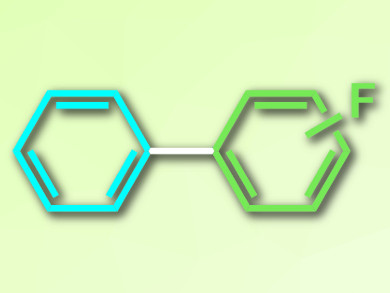A Base-Free Twist on Biaryl Synthesis
Almost 40 years after its discovery [1, 2], the Suzuki-Miyaura coupling reaction has a new, base-free twist. The reaction is one of the most widely used coupling reactions to form biaryls. However, despite its broad scope and mild conditions, it has its limitations, mainly due to the mandatory use of a base. Melanie S. Sanford and colleagues, University of Michigan, Ann Arbor, USA, have developed a truly base-free version, which uses acyl fluoride substrates and nickel catalysis. The team especially targets the preparation of biaryls containing fluorine substituents.
In a typical Suzuki-Miyaura reaction, one of the coupling partners is an aryl boronic acid, the other one is an organohalide or pseudohalide, and the catalyst is palladium(0). A base, e.g., a carbonate or an amine, activates the palladium aryl complex so that it can undergo a transmetalation with the aryl boronate to form the biaryl after reductive elimination.
Pharmaceutical companies and synthetic organic chemists have prepared a vast variety of bioactive compounds including important anticancer drugs and natural products, as well as liquid crystals and polymers, with ever improved versions of the reaction. For his contributions to the coupling reaction, Suzuki received the Nobel Prize in Chemistry in 2010 together with Ei-ichi Negishi and Richard Heck. However, some substrates, especially those containing fluorine, pose problems.
Fluorine Substituents and Bases Are a Bad Combination
Fluorine substituents are increasingly attractive for pharmaceuticals because they can make a compound more lipophilic and less prone to metabolic degradation without changing the structure too much. But their high electronegativity is a drawback because fluorinated aryl boronic acids are unstable in the presence of bases: They simply lose their boronate substituent and decompose. These side reactions reduce the yield of the biaryl product.
The team looked for alternatives. In Suzuki-Miyaura reactions, the mechanism typically starts with the palladium(0) catalyst inserting into the aryl–halide bond while being oxidized. Replacement of the halide by a hydroxide from the base gives the active intermediate, which can be attacked by the aryl boronate. If they planned to avoid the base, the researchers had to focus on the initial steps before the base enters the reaction.
Nickel as a Cheap and Environmentally Friendly Catalyst
As nickel complexes can insert into aryl acyl fluorides through oxidative addition, and because they are cheaper and more environmentally friendly than palladium catalysts, the team investigated if a combination of nickel and benzoyl fluorides could be useful in the Suzuki-Miyaura coupling. They found that nickel inserted smoothly into the acyl bond, formed a benzoyl nickel fluoride intermediate, and then rapidly kicked out carbon monoxide to give a phenyl nickel fluoride complex. This complex reacted smoothly with aryl boronic acids, even fluorinated ones, through a transmetalation and the reductive elimination of nickel(0), in analogy to the transmetalation-active complex in the original Suzuki-Miyaura coupling, The altered reaction cycle gave the fluorinated biaryl in excellent yield.
The change from an aryl halide to an aryl acyl fluoride substrate and from a palladium(0) to a nickel(0) catalyst made the use of bases for activation redundant. The trick was to combine the acyl fluoride with the decarbonylation- and insertion ability of nickel. However, the new substrates, aryl acyl fluorides, must be prepared first. This is not difficult: modern fluorine chemistry allows chemists to transform ordinary aryl acids quickly and quantitatively to their fluorides.
Testing a large variety of substrates, the researchers found mostly good to excellent yields, and they remarked that all reagents were uncomplicated and cheap, and the conditions mild. The developed base-free coupling reaction has advantages for the preparation of fluorine biaryl derivatives and other base-sensitive aromatic compounds. Almost 40 years after Norio Miyaura and Akira Suzuki introduced their first palladium-catalyzed biaryl forming reaction with aryl boronic acids and aryl halides as substrates, their reaction has got a refreshing new twist.
- Base-free nickel-catalysed decarbonylative Suzuki–Miyaura coupling of acid fluorides,
Christian A. Malapit, James R. Bour, Conor E. Brigham, Melanie S. Sanford,
Nature 2018.
https://doi.org/10.1038/s41586-018-0628-7
References
- [1] A new stereospecific cross-coupling by the palladium-catalyzed reaction of 1-alkenylboranes with 1-alkenyl or 1-alkynyl halides,
Norio Miyaura, Kinji Yamada, Akira Suzuki,
Tetrahedron Lett. 1979, 20, 3437–3440.
https://doi.org/10.1016/S0040-4039(01)95429-2 - [2] Stereoselective synthesis of arylated (E)-alkenes by the reaction of alk-1-enylboranes with aryl halides in the presence of palladium catalyst,
Norio Miyaura, Akira Suzuki,
J. Chem. Soc. Chem. Commun. 1979.
https://doi.org/10.1039/c39790000866




